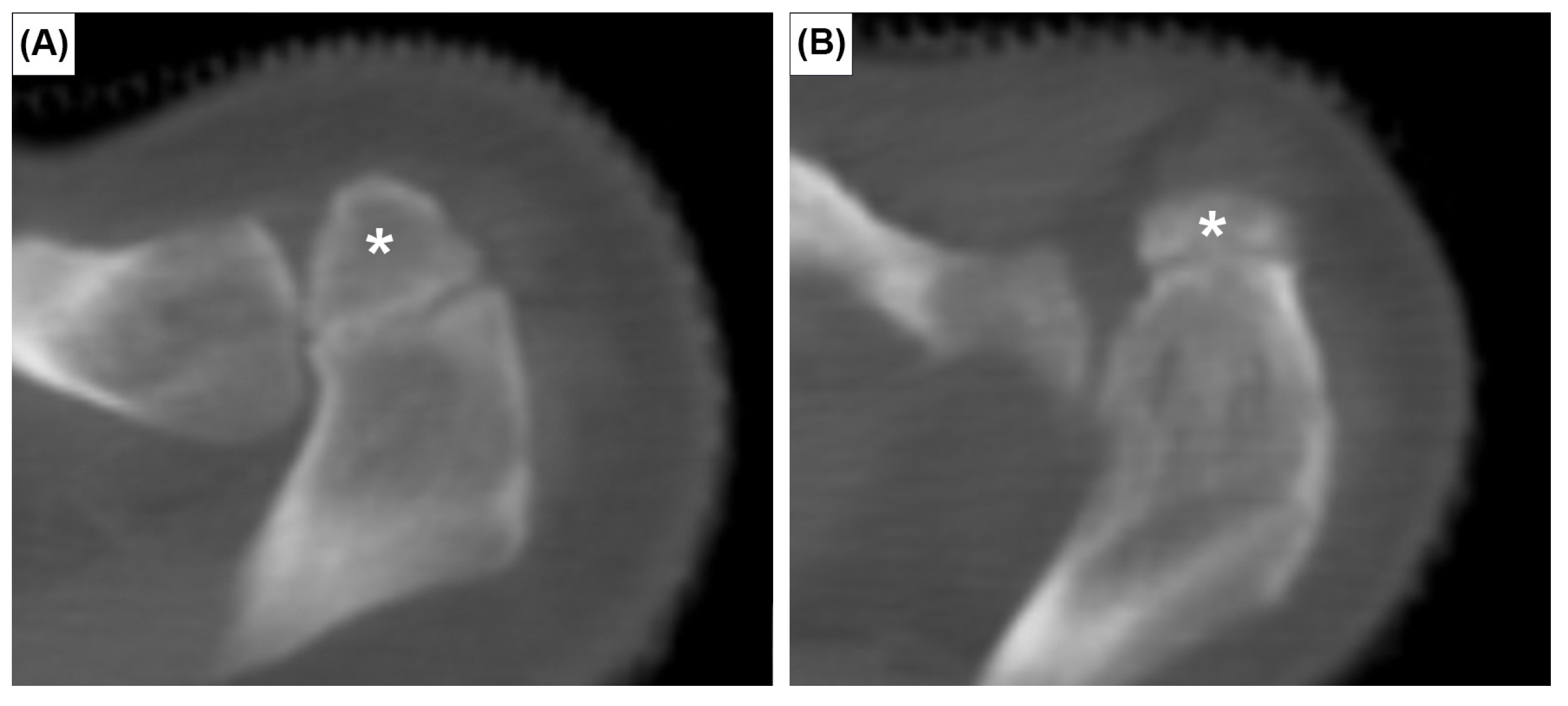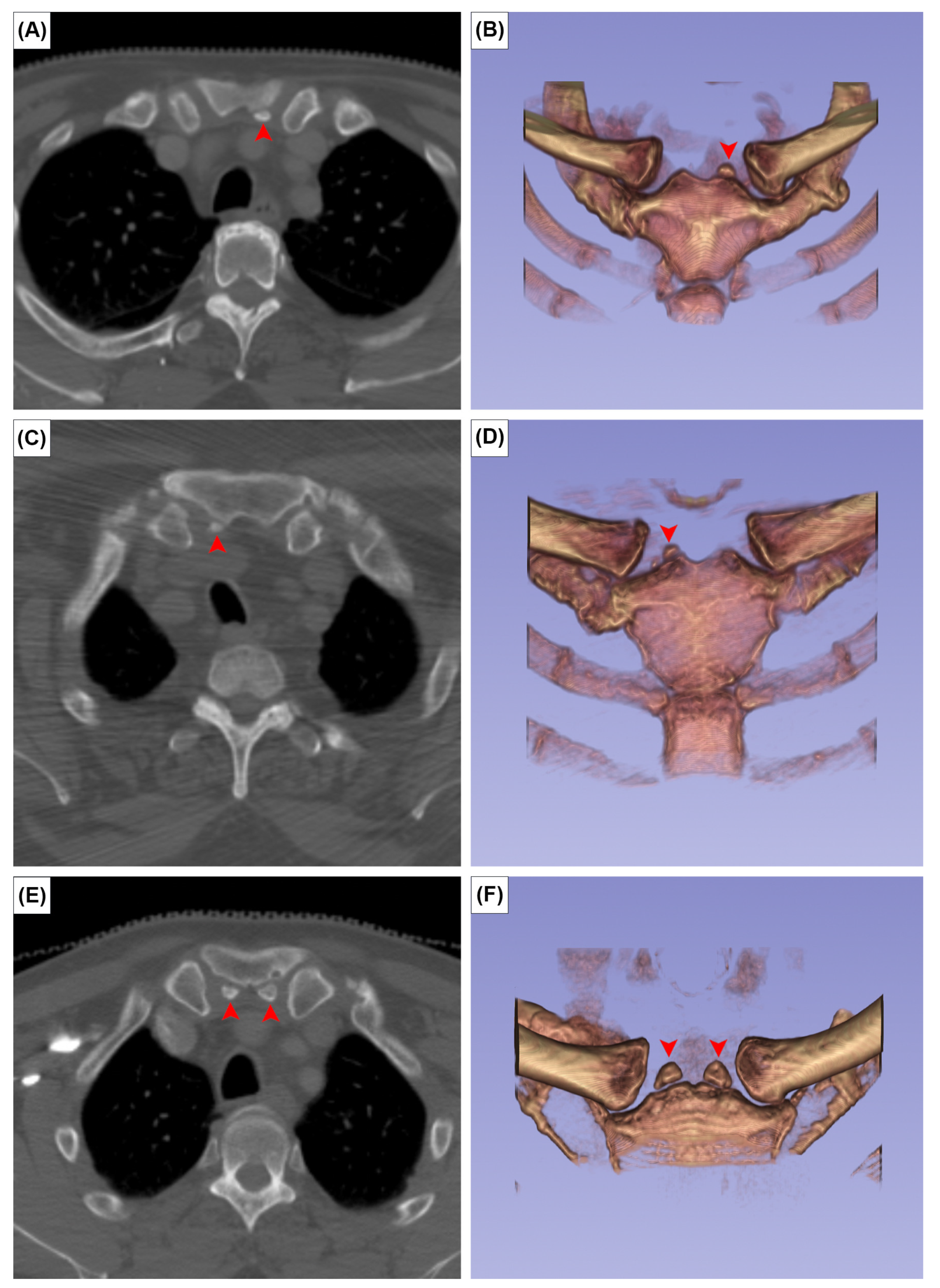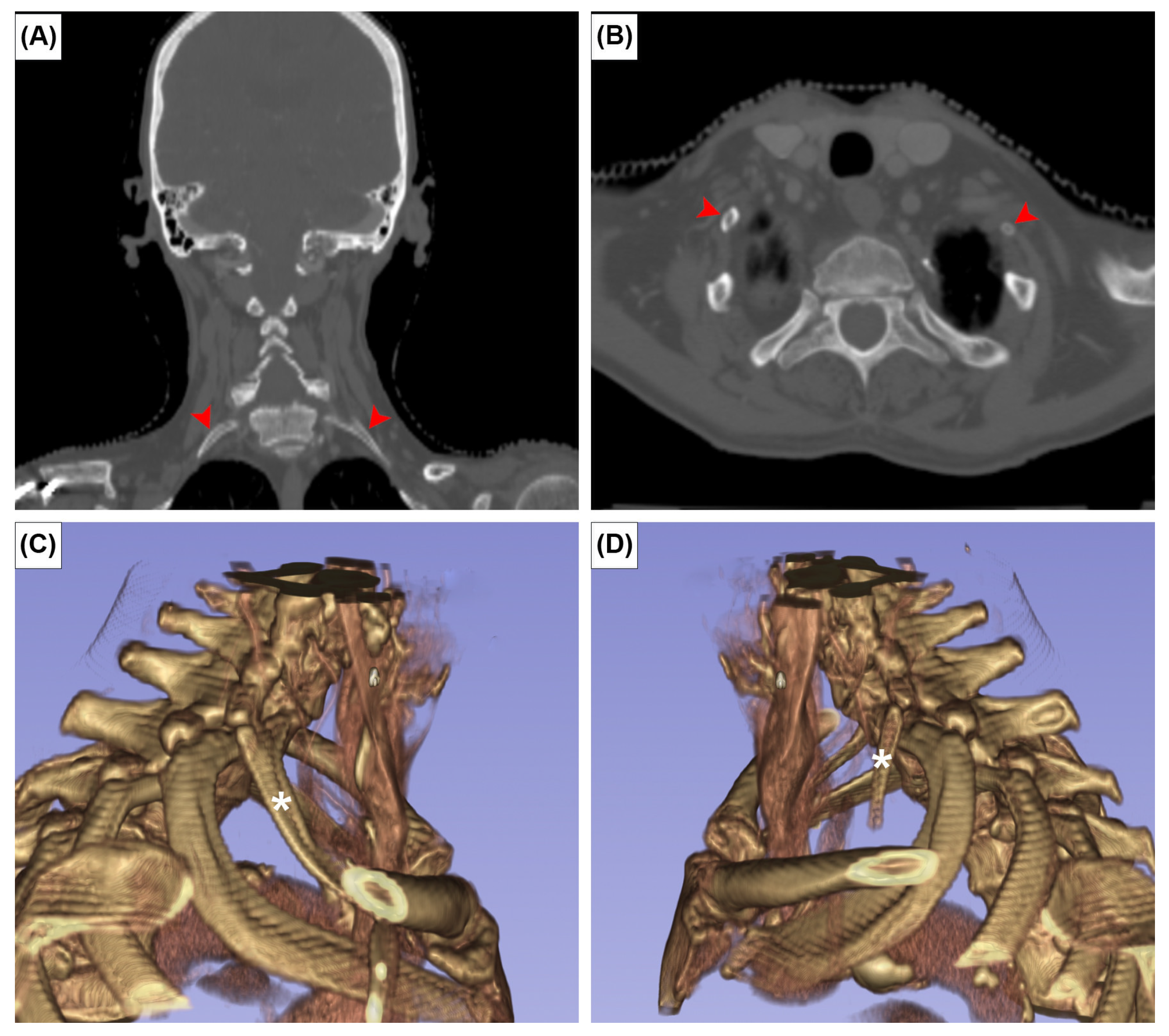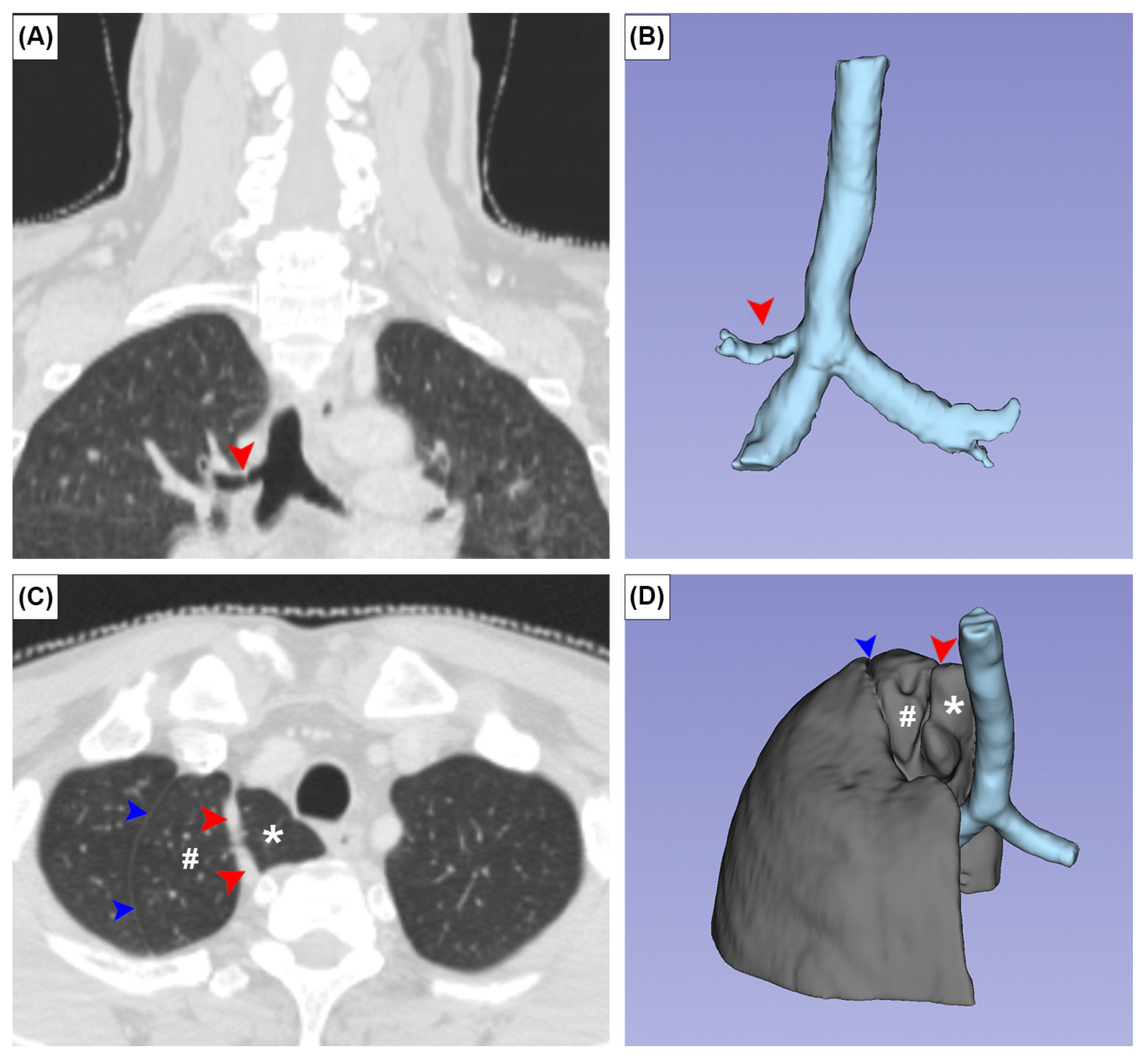Anatomical Variants Identified on Computed Tomography of Oropharyngeal Carcinoma Patients
Abstract
1. Introduction
2. Materials and Methods
2.1. Imaging Dataset
2.2. Image Analysis
3. Results
3.1. Data Exploration and Exclusion
3.2. Prevalences of Six Anatomical Variants
4. Discussion
5. Conclusions
Author Contributions
Funding
Institutional Review Board Statement
Informed Consent Statement
Data Availability Statement
Conflicts of Interest
References
- Cahill, D.R.; Leonard, R.J. Missteps and masquerade in American medical academe: Clinical anatomists call for action. Clin. Anat. 1999, 12, 220–222. [Google Scholar] [CrossRef]
- Sañudo, J.R.; Vasques, R.; Puerta, J. Meaning and clinical interest of the anatomical variations in the 21st century. Eur. J. Anat. 2003, 7, 1–3. [Google Scholar]
- Jemal, A.; Bray, F.; Center, M.M.; Ferlay, J.; Ward, E.; Forman, D. Global cancer statistics. Cancer J. Clin. 2011, 61, 69–90. [Google Scholar] [CrossRef]
- McLeod, N.M.; Jess, A.; Anand, R.; Tilley, E.; Higgins, B.; Brennan, P.A. Role of chest CT in staging of oropharyngeal cancer: A systematic review. Head Neck 2009, 31, 548–555. [Google Scholar] [CrossRef]
- García-Pola, M.; Pons-Fuster, E.; Suárez-Fernández, C.; Seoane-Romero, J.; Romero-Méndez, A.; López-Jornet, P. Role of artificial intelligence in the early diagnosis of oral cancer. A scoping review. Cancers 2021, 13, 4600. [Google Scholar] [CrossRef]
- Yurasakpong, L.; Asuvapongpatana, S.; Weerachatyanukul, W.; Meemon, K.; Jongkamonwiwat, N.; Kruepunga, N.; Chaiyamoon, A.; Sudsang, T.; Iwanaga, J.; Tubbs, R.S. Anatomical variants identified on chest computed tomography of 1000+ COVID-19 patients from an open-access dataset. Clin. Anat. 2022, 35, 723–731. [Google Scholar] [CrossRef] [PubMed]
- Yammine, K. The prevalence of os acromiale: A systematic review and meta-analysis. Clin. Anat. 2014, 27, 610–621. [Google Scholar] [CrossRef] [PubMed]
- Turkay, R.; Inci, E.; Ors, S.; Nalbant, M.O.; Gurses, I.A. Frequency of sternal variations in living individuals. Surg. Radiol. Anat. 2017, 39, 1273–1278. [Google Scholar] [CrossRef]
- Vatzia, K.; Fanariotis, M.; Makridis, K.G.; Vlychou, M.; Fezoulidis, I.V.; Vassiou, K. Frequency of sternal variations and anomalies in living individuals evaluated by MDCT. Eur. J. Radiol. 2021, 142, 109828. [Google Scholar] [CrossRef]
- Ogawa, K.; Fukuda, H.; Omori, K. Suprasternal bone. Nihon Seikeigeka Gakkai Zasshi 1979, 53, 155–164. [Google Scholar] [PubMed]
- Stark, P.; Watkins, G.E.; Hildebrandt-Stark, H.E.; Dunbar, R.D. Episternal ossicles. Radiology 1987, 165, 143–144. [Google Scholar] [CrossRef] [PubMed]
- Henry, B.M.; Vikse, J.; Sanna, B.; Taterra, D.; Gomulska, M.; Pękala, P.A.; Tubbs, R.S.; Tomaszewski, K.A. Cervical rib prevalence and its association with thoracic outlet syndrome: A meta-analysis of 141 studies with surgical considerations. World Neurosurg. 2018, 110, e965–e978. [Google Scholar] [CrossRef]
- Chaweeborisuit, P.; Yurasakpong, L.; Kruepunga, N.; Tubbs, R.S.; Chaiyamoon, A.; Suwannakhan, A. The prevalence of Stafne bone cavity: A meta-analysis of 355,890 individuals. J. Dent. Sci. 2022, 18, 594–603. [Google Scholar] [CrossRef]
- Yurasakpong, L.; Yammine, K.; Limpanuparb, T.; Janta, S.; Chaiyamoon, A.; Kruepunga, N.; Meemon, K.; Suwannakhan, A. The prevalence of the azygos lobe: A meta-analysis of 1,033,083 subjects. Clin. Anat. 2021, 34, 872–883. [Google Scholar] [CrossRef]
- Wong, L.M.; Cheruiyot, I.; de Oliveira, M.H.S.; Keet, K.; Tomaszewski, K.A.; Walocha, J.A.; Tubbs, S.; Henry, B.M. Congenital Anomalies of the Tracheobronchial Tree: A Meta-Analysis and Clinical Considerations. Ann. Thorac. Surg. 2021, 112, 315–325. [Google Scholar] [CrossRef]
- Kwan, J.Y.Y.; Su, J.; Huang, S.; Ghoraie, L.; Xu, W.; Chan, B.; Yip, K.; Giuliani, M.; Bayley, A.; Kim, J. Data from radiomic biomarkers to refine risk models for distant metastasis in oropharyngeal carcinoma. Cancer Imaging Arch. 2019, 102, 1107–1116. [Google Scholar]
- Fedorov, A.; Beichel, R.; Kalpathy-Cramer, J.; Finet, J.; Fillion-Robin, J.-C.; Pujol, S.; Bauer, C.; Jennings, D.; Fennessy, F.; Sonka, M.; et al. 3D Slicer as an image computing platform for the quantitative Imaging Network. Magn. Reson. Imaging 2012, 30, 1323–1341. [Google Scholar] [CrossRef] [PubMed]
- Tortora, M.; Gemini, L.; Scaravilli, A.; Ugga, L.; Ponsiglione, A.; Stanzione, A.; D’Arco, F.; D’Anna, G.; Cuocolo, R. Radiomics applications in head and neck tumor imaging: A narrative review. Cancers 2023, 15, 1174. [Google Scholar] [CrossRef]
- Parmar, C.; Grossmann, P.; Rietveld, D.; Rietbergen, M.M.; Lambin, P.; Aerts, H.J. Radiomic machine-learning classifiers for prognostic biomarkers of head and neck cancer. Front. Oncol. 2015, 5, 272. [Google Scholar] [CrossRef]
- Shakouri, S.; Bakhshali, M.A.; Layegh, P.; Kiani, B.; Masoumi, F.; Ataei Nakhaei, S.; Mostafavi, S.M. COVID19-CT-dataset: An open-access chest CT image repository of 1000+ patients with confirmed COVID-19 diagnosis. BMC Res. Notes 2021, 14, 178. [Google Scholar] [CrossRef]
- Clark, K.; Vendt, B.; Smith, K.; Freymann, J.; Kirby, J.; Koppel, P.; Moore, S.; Phillips, S.; Maffitt, D.; Pringle, M. The Cancer Imaging Archive (TCIA): Maintaining and operating a public information repository. J. Digit. Imaging 2013, 26, 1045–1057. [Google Scholar] [CrossRef]
- Shen, L.; Dong, J.; Li, S.; Wang, Y.; Dong, A.; Shu, W.; Wu, M.; Pan, C.; Xia, Y.; Wu, P. M1 stage subdivision and treatment outcome of patients with bone-only metastasis of nasopharyngeal carcinoma. Oncologist 2015, 20, 291–298. [Google Scholar] [CrossRef]
- Teo, P.M.; Kwan, W.H.; Lee, W.Y.; Leung, S.F.; Johnson, P.J. Prognosticators determining survival subsequent to distant metastasis from nasopharyngeal carcinoma. Cancer 1996, 77, 2423–2431. [Google Scholar] [CrossRef]
- Roodman, G.D.; Silbermann, R. Mechanisms of osteolytic and osteoblastic skeletal lesions. Bonekey Rep. 2015, 4, 753. [Google Scholar]
- Girgis, S.; Leaky, N.; Ali, E.; Cheng, L. Mandibular tuberculosis presenting as a squamous cell carcinoma. Oral. Maxillofac. Surg. Cases 2018, 4, 161–162. [Google Scholar] [CrossRef]
- Prasatkaew, W.; Kruepunga, N.; Yurasakpong, L.; Korkong, R.; Ardsawang, S.; Ronglakorn, S.; Sananpanich, K.; Suksri, S.; Suwannakhan, A. A reverse form of Linburg–Comstock variation with comments on its etiology and demonstration of interactive 3D portable document format. Surg. Radiol. Anat. 2021, 44, 227–232. [Google Scholar] [CrossRef]
- Cunningham, C.; Scheuer, L.; Black, S. Developmental Juvenile Osteology; Academic Press: Cambridge, MA, USA, 2016. [Google Scholar]
- Angel, J.L.; Kelley, J.O.; Parrington, M.; Pinter, S. Life stresses of the free black community as represented by the First African Baptist Church, Philadelphia, 1823–1841. Am. J. Phys. Anthropol. 1987, 74, 213–229. [Google Scholar] [CrossRef]
- Brooke, B.S.; Freischlag, J.A. Contemporary management of thoracic outlet syndrome. Curr. Opin. Cardiol. 2010, 25, 535–540. [Google Scholar] [CrossRef]
- Choukas, N. Etiology of static bone defect of the mandible. J. Oral Surg. Anesth Hosp. Dent. Serv. 1960, 18, 16–20. [Google Scholar]
- Herbozo Silva, P.; Briones Sindermann, D.; Martinez Rondanelli, B. Giant mandibular bone defect: Report of a case. J. Oral Maxillofac. Surg. 2006, 64, 145–150. [Google Scholar] [CrossRef]
- Stafne, E.C. Bone cavities situated near the angle of the mandible. J. Am. Dent. Assoc. 1942, 29, 1969–1972. [Google Scholar] [CrossRef]
- Sandy, J.R.; Williams, D.M. Anterior salivary gland inclusion in the mandible: Pathological entity or anatomical variant? Br. J. Oral Maxillofac. Surg. 1981, 19, 223–229. [Google Scholar] [CrossRef] [PubMed]
- Seward, G.R. Salivary gland inclusions in the mandible. Br. Dent. J. 1960, 108, 321–325. [Google Scholar]
- Salve, V.T.; Atram, J.S.; Mhaske, Y.V. Azygos lobe presenting as right para-tracheal shadow. Lung India 2015, 32, 85–86. [Google Scholar] [CrossRef] [PubMed]
- Tran, C.T.; Miao, K.H.; Lui, F. Anatomy, Thorax, Lung Azygos Lobe; StatPearls Publishing: Treasure Island, FL, USA, 2022. [Google Scholar]
- Jamil, A.; Soos, M.P. Tracheal Bronchus; StatPearls Publishing: Treasure Island, FL, USA, 2022. [Google Scholar]
- Yete, S.; D’Souza, W.; Saranath, D. High-risk human papillomavirus in oral cancer: Clinical implications. Oncology 2018, 94, 133–141. [Google Scholar] [CrossRef] [PubMed]




| Structure and Types | Overall Prevalence | Sex-Based Prevalence (%) | p-Values | |
|---|---|---|---|---|
| Male | Female | |||
| Os Acromiale (OA) | 19/606 (3.1%) | 18/481 (3.7%) | 1/125 (0.8%) | 0.09 |
| Os acromiale (OA) (true) | 23/1212 (1.9%) | N/A | N/A | - |
| Left | 9/19 (47.4%) | 9/18 (50%) | 0/1 (0%) | - |
| Right | 6/19 (31.6%) | 6/18 (33.3%) | 0/1 (0%) | - |
| Bilateral Pre-acromion (true) | 4/19 (21.0%) | 3/18 (16.7%) | 1/1 (100%) | - |
| 4/23 (17.4%) | N/A | N/A | - | |
| Meso-acromion (true) | 19/23 (82.6%) | N/A | N/A | - |
| Meta-acromion (true) | 0/23 (0.0%) | N/A | N/A | - |
| Episternal ossicles (EOs) | 14/590 (2.2%) | 12/466 (2.6%) | 2/124 (1.6%) | 0.49 |
| Left | 6/14 (42.9%) | 5/11 (45.5%) | 1/3 (33.3%) | - |
| Right | 3/14 (21.4%) | 2/11 (18.2%) | 1/3 (33.3%) | - |
| Bilateral | 5/14 (35.7%) | 4/11 (36.4%) | 1/3 (33.3%) | - |
| Cervical rib (CR) | 1/606 (0.2%) | 0/481 (0%) | 1/125 (0.8%) | 0.05 * |
| Stafne bone cavity (SBC) | 0/606 (0.0%) | 0/481 (0%) | 0/125 (0%) | - |
| Azygos lobe (AL) | 2/606 (0.3%) | 1/481 (0.2%) | 1/125 (0.8%) | 0.30 |
| Tracheal bronchus (TB) | 3/604 (0.5%) | 2/480 (0.4%) | 1/124 (0.8%) | 0.58 |
Disclaimer/Publisher’s Note: The statements, opinions and data contained in all publications are solely those of the individual author(s) and contributor(s) and not of MDPI and/or the editor(s). MDPI and/or the editor(s) disclaim responsibility for any injury to people or property resulting from any ideas, methods, instructions or products referred to in the content. |
© 2023 by the authors. Licensee MDPI, Basel, Switzerland. This article is an open access article distributed under the terms and conditions of the Creative Commons Attribution (CC BY) license (https://creativecommons.org/licenses/by/4.0/).
Share and Cite
Janta, S.; Suwannakhan, A.; Yurasakpong, L.; Chaiyamoon, A.; Kruepunga, N.; Iwanaga, J.; Tubbs, R.S.; Eiamratchanee, P.; Paensukyen, T. Anatomical Variants Identified on Computed Tomography of Oropharyngeal Carcinoma Patients. Medicina 2023, 59, 707. https://doi.org/10.3390/medicina59040707
Janta S, Suwannakhan A, Yurasakpong L, Chaiyamoon A, Kruepunga N, Iwanaga J, Tubbs RS, Eiamratchanee P, Paensukyen T. Anatomical Variants Identified on Computed Tomography of Oropharyngeal Carcinoma Patients. Medicina. 2023; 59(4):707. https://doi.org/10.3390/medicina59040707
Chicago/Turabian StyleJanta, Sirorat, Athikhun Suwannakhan, Laphatrada Yurasakpong, Arada Chaiyamoon, Nutmethee Kruepunga, Joe Iwanaga, R. Shane Tubbs, Pinthusorn Eiamratchanee, and Tawanrat Paensukyen. 2023. "Anatomical Variants Identified on Computed Tomography of Oropharyngeal Carcinoma Patients" Medicina 59, no. 4: 707. https://doi.org/10.3390/medicina59040707
APA StyleJanta, S., Suwannakhan, A., Yurasakpong, L., Chaiyamoon, A., Kruepunga, N., Iwanaga, J., Tubbs, R. S., Eiamratchanee, P., & Paensukyen, T. (2023). Anatomical Variants Identified on Computed Tomography of Oropharyngeal Carcinoma Patients. Medicina, 59(4), 707. https://doi.org/10.3390/medicina59040707





